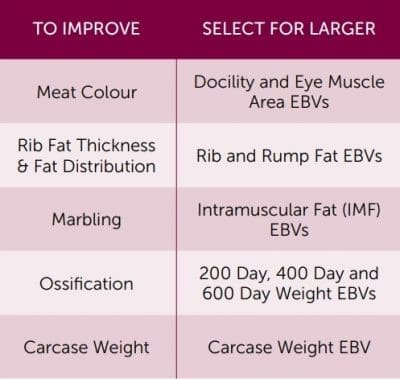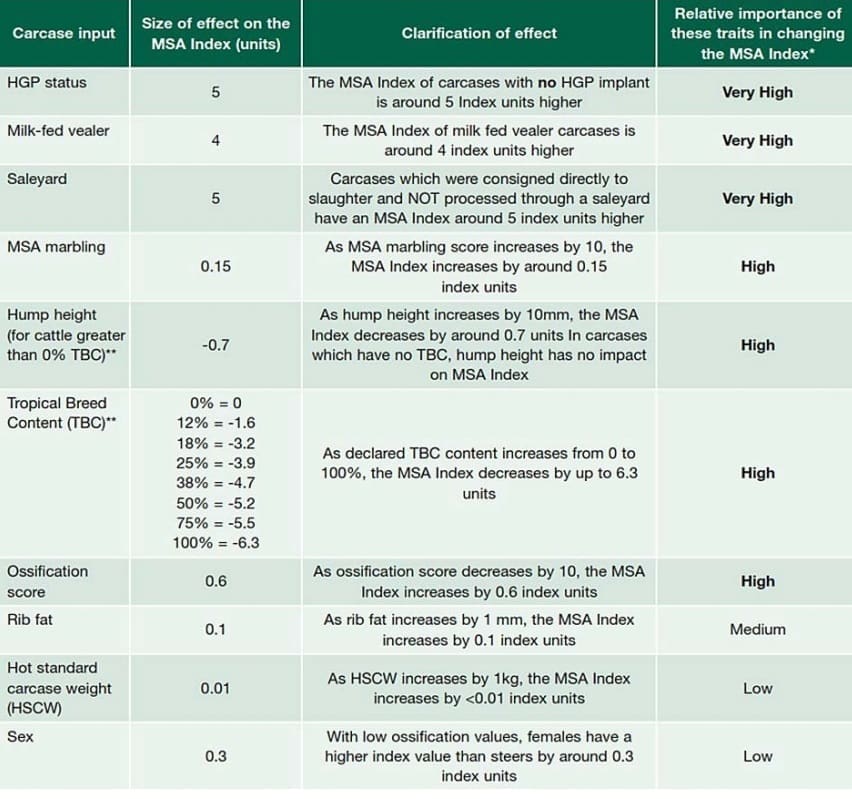WHILE many of the factors that affect the eating quality of a carcase and its suitability for Meat Standards Australia programs are heavily influenced by animal handling and management, many factors are also influenced by the genetics of an animal.
Selection of animals with acceptable temperament, higher Docility EBVs, higher Eye Muscle Area EBVs and appropriate Rib & Rump Fat EBVs can improve MSA compliance, whilst selection of animals with higher IMF EBVs to increase marbling score, higher Growth EBVs to reduce ossification score, higher Rib Fat EBVs to increase carcase fatness and higher Carcase Weight EBVs to increase HSCW at the same maturity, will increase MSA Index values and thus increase the eating quality of your herd.
Factors Underlying the MSA Index
The key factors impacting on eating quality that are influenced by the producer include:
- Tropical breed content, verified or determined by hump height measurement
- MSA Marbling Score
- Ossification
- Hormonal Growth Promotant (HGP) Status
- Saleyard Status
- Rib Fat
- Hot Standard Carcase Weight (HSCW), and
- Gender
The effect that each of the individual factors has on MSA Index varies. Whether an animal has been treated with an HGP and/or whether an animal has been sold directly to slaughter have a very high impact on the overall MSA Index value of a carcase, followed by MSA Marbling Score, hump height, tropical breed content and ossification. Rib fat, HSCW and gender have relatively lower impacts on the overall MSA Index value.
Selecting Genetics to Improve MSA Index Score
While animal management and handling play a big role in factors that affect the MSA Index, there is also an opportunity to increase MSA Index values through genetic selection.
Marbling:
MSA Marbling Score is an assessment of the intramuscular fat deposits at the quartered site between the 5th and 13th ribs. MSA Marbling Score provides an indication of the distribution and piece size, as well as the amount of marbling. MSA marbling scores range from 100 to 1190 in increments of 10, with higher scores indicating greater marbling. As MSA Marbling Score increases by 10, the MSA Index has the potential to increase by 0.15 Index units, or rather an increase in MSA Marbling Score of 100 (roughly equivalent to a 1 unit increase in AUSMeat marbling score) equates to a 1.5 unit increase in MSA Index.
Selection for improved MSA marbling score can be achieved by selecting animals with higher Intramuscular Fat (IMF) EBVs. Intramuscular Fat EBVs are estimates of genetic differences between animals in intramuscular fat at the 12/13th rib site in a standard weight steer carcase, with higher IMF EBVs associated with greater marbling in the carcase.
For example, an animal with an IMF EBV of +2.9pc would be expected to produce progeny with more marbling in a standard carcase than the progeny of an animal with an IMF EBV of +0.2pc.
Ossification
Ossification is the process whereby the cartilage present around the bones changes into bone as the animal matures, and is a measure of the physiological maturity of the carcase. Although it can be roughly associated with the animal’s chronological age, ossification takes into account the entire developmental lifespan of the animal which may be affected by nutrition, sickness and/ or temperament.
 MSA Ossification scores range from 100 to 590 in increments of 10, with lower scores indicating less physiological maturity. As ossification score decreases by 10, the MSA Index potentially increases by 0.6 Index units, or rather, a decrease in ossification score of 100 equates to an increase in MSA Index of 6 units. Therefore younger animals with lower levels of ossification tend to have a higher MSA index values than older animals with higher ossification values.
MSA Ossification scores range from 100 to 590 in increments of 10, with lower scores indicating less physiological maturity. As ossification score decreases by 10, the MSA Index potentially increases by 0.6 Index units, or rather, a decrease in ossification score of 100 equates to an increase in MSA Index of 6 units. Therefore younger animals with lower levels of ossification tend to have a higher MSA index values than older animals with higher ossification values.
Selection for lower ossification scores can be achieved by selecting animals with higher 200 Day Growth, 400 Day Weight and 600 Day Weight EBVs, as calves which grow more quickly will reach target live weights at a younger age with lower ossification score. 200 Day Growth EBV, 400 Day Weight EBV and 600 Day Weight EBV estimate the genetic differences between animals in live weight at 200, 400 and 600 days respectively due to an animal’s growth genetics.
In all three cases, higher EBVs are associated with heavier weights at the respective age. For example, an animal with a 400 Day Weight EBV of +60 kg would be expected to produce heavier progeny at 400 days of age than an animal with a 400 Day Weight EBV of +20 kg.
Rib Fat
While of utmost importance in determining whether carcases are compliant to MSA specifications, rib fat thickness also has an impact on MSA Index. A 1mm increase in rib fat corresponds to a potential n increase in the MSA Index of 0.1 Index units, or rather, an increase of 10mm in fat depth equates to an increase in MSA Index of 1 unit.
Selection for increased rib fat can be achieved by selection of animals with higher Rib Fat EBVs. Rib Fat EBVs are estimates of the genetic differences between animals in fat depth at the 12/13th rib site in a standard weight steer carcase, with higher EBVs associated with greater fat depth.
While a higher level of rib fat is favourable for superior eating quality and MSA index, this benefit needs to be balanced with the negative effect that higher levels of rib fat may have on carcase yield.
Carcase Weight
Whilst an important specification in most livestock grids, carcase weight only has a small impact on MSA Index, with MSA calculating that as HSCW increases by 1kg, the MSA Index will potentially increase by less than 0.01 Index units. In other words, an increase in HSCW of 100kg equates to an increase in MSA Index of 1 unit.
To select for heavier carcases at the same maturity (ossification), animals with higher Carcase Weight EBVs should be selected. Carcase Weight EBVs are estimates of the genetic differences between animals in hot standard carcase weight, with higher Carcase Weight EBVs associated with heavier carcases.
For example, an animal with a Carcase Weight EBV of +60 kg would be expected to produce progeny with heavier carcases than an animal with a Carcase Weight EBV of +30 kg.
To further discuss breeding for MSA programs, contact Southern Beef Technology Services (SBTS) or Tropical Beef Technology Services (TBTS).




HAVE YOUR SAY